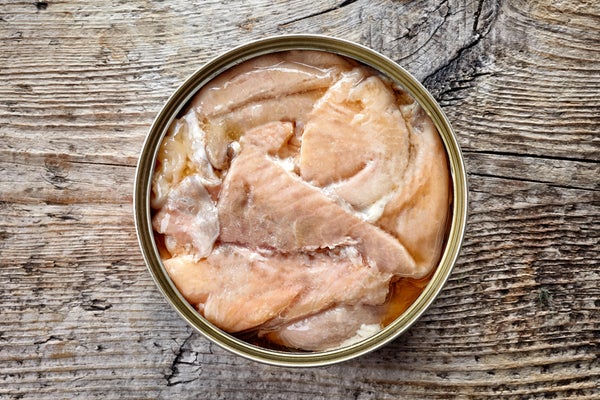Decades-old Cans of Salmon Reveal Changes in Ocean Health
Researchers used tinned fish to reconstruct parasitic population change, giving new meaning to the phrase “opening a can of worms”

Reinis Bigacs/Alamy Stock Photo
Chelsea Wood, a parasite ecologist at the University of Washington, and her then graduate student Natalie Mastick had been pondering for months how they could reconstruct fluctuations over time in the risk parasites pose to marine mammals in the Pacific Northwest. No long-term datasets exist for the vast majority of parasitic species, so Wood and Mastick knew they’d have to get creative. One idea they had was to use salmon’s parasitic loads as proxies for marine mammal infection.
Killer whales, seals and belugas prey on salmon, which are an intermediate host for various nematodes that complete their several-step life cycle in those predators. The parasites cannot breed and enter the environment without marine mammals, so the level of infection in salmon is intimately tied to that of their predators.
While the logic behind the researchers’ idea of using salmon parasites to understand marine mammal parasites was sound, there was still one problem: Where would they get a bunch of old salmon that they could dissect to look for parasites?
On supporting science journalism
If you’re enjoying this article, consider supporting our award-winning journalism by subscribing. By purchasing a subscription you are helping to ensure the future of impactful stories about the discoveries and ideas shaping our world today.
They seemed to be out of options when, “out of the blue,” Wood says, she received a call from the Seafood Products Association, a trade organization in Seattle. The group told her it was cleaning out its basement and was getting rid of stacks of dusty boxes of long-expired canned salmon. Before throwing the cans away, the association wondered if Wood might want them.
“We were like, ‘Worms could be in there!’” Wood recalls. “That’s how we started on this study: [the Seafood Products Association] asking us if we wanted this trash from their basement and us saying, ‘Absolutely, yes.’”
Wood and Mastick’s hunch about canned salmon possibly serving as a time capsule for worms turned out to be correct: the tinned fish contained lots of parasites. As the researchers reported this week in Ecology and Evolution, they were able to use the recovered parasites to reconstruct how infection burden has changed over the course of 42 years in four salmon species and found that it increased in two. While this might sound like a bad thing, the researchers suspect that the uptick in worms signals “a conservation success story” for marine mammals, Wood says. “It’s possible as marine mammals have come back, their parasites have come back, too.”
Canned salmon gets cooked as it’s sealed, so going into the study, the researchers were unsure whether they would be able to detect any anisakids, the type of parasitic nematodes that infect the muscle of Alaskan salmon. The worms, however, “were very noticeable—at least for us,” Wood says. “We were really surprised.”
Anisakids find their way into salmon through smaller intermediate hosts such as krill or fish. After the salmon eat those smaller hosts, the parasites burrow into the salmon’s muscle, making “a little pocket,” Wood says. She and her colleagues carefully picked through the salmon muscle tissue with forceps, and when they opened one of the pockets, the worms tended to “spring out,” Wood says. “They were very easily visible.” (These worms occur in many types of seafood, she adds, and because they are killed in the cooking process, they pose no danger to humans unless food is undercooked or a person has a particular allergy to them.)
The basement stash that enabled the findings consisted of 502 cans of chum, coho, pink and sockeye salmon, mostly from Alaska. The researchers dissected 178 cans in total, processed between 1979 and 2019 and varying from 22 to 62 cans per species. Half the cans contained nematodes, and they collected a total of 372 worms. They found that the number of worms per gram of tissue significantly increased over time in chum and pink salmon but that it did not change in sockeye or coho salmon.
“It’s important we understand how parasites and disease generally are influencing ecosystems because effects can be profound,” says Ryan Carnegie, a biologist at the Virginia Institute of Marine Science, who was not involved in the research. “The notion to use this archive of canned samples to address the question of long-term nematode infection in salmon was simply inspired, and importantly, it was followed by robust and very careful approaches to generate solid quantitative data to test the hypothesis of change.”
The authors of the new study cannot say for sure what factors are driving the increase in parasite numbers in chum and pink salmon. But the uptick does coincide with the creation of the Marine Mammal Protection Act, which went into effect in 1972. Populations of various marine mammals have increased since then, so it tracks, Wood says, that their parasites would have increased, too. Other studies have revealed similar correlations tied to conservation actions, including an increase of parasites in Baltic cod as gray seal populations recovered. As Wood notes, “We know this because fishermen were pissed because they kept landing all this cod ridden with worms.”
Wood and her colleagues also do not know why sockeye or coho salmon did not experience an increase in parasite loads. They are hoping to find some ecological hints at this answer through a genetic analysis they are currently working on to try to identify the specific parasitic species recovered from the tinned salmon.
Already, the new research provides “a view into some of the most hard-to-study species and gives insight into the nuanced way that ecosystems recover,” says Loren McClenachan, an ocean historian at the University of Victoria in British Columbia, who was not involved in the research.
“Using canned salmon as a window into past ecosystems is a remarkably creative approach to reveal otherwise invisible change,” she says. “The finding that parasites have increased in some salmon species as their marine mammal hosts have increased is notable and shows that baselines for healthy ocean ecosystems may be wormier than people might think.”

